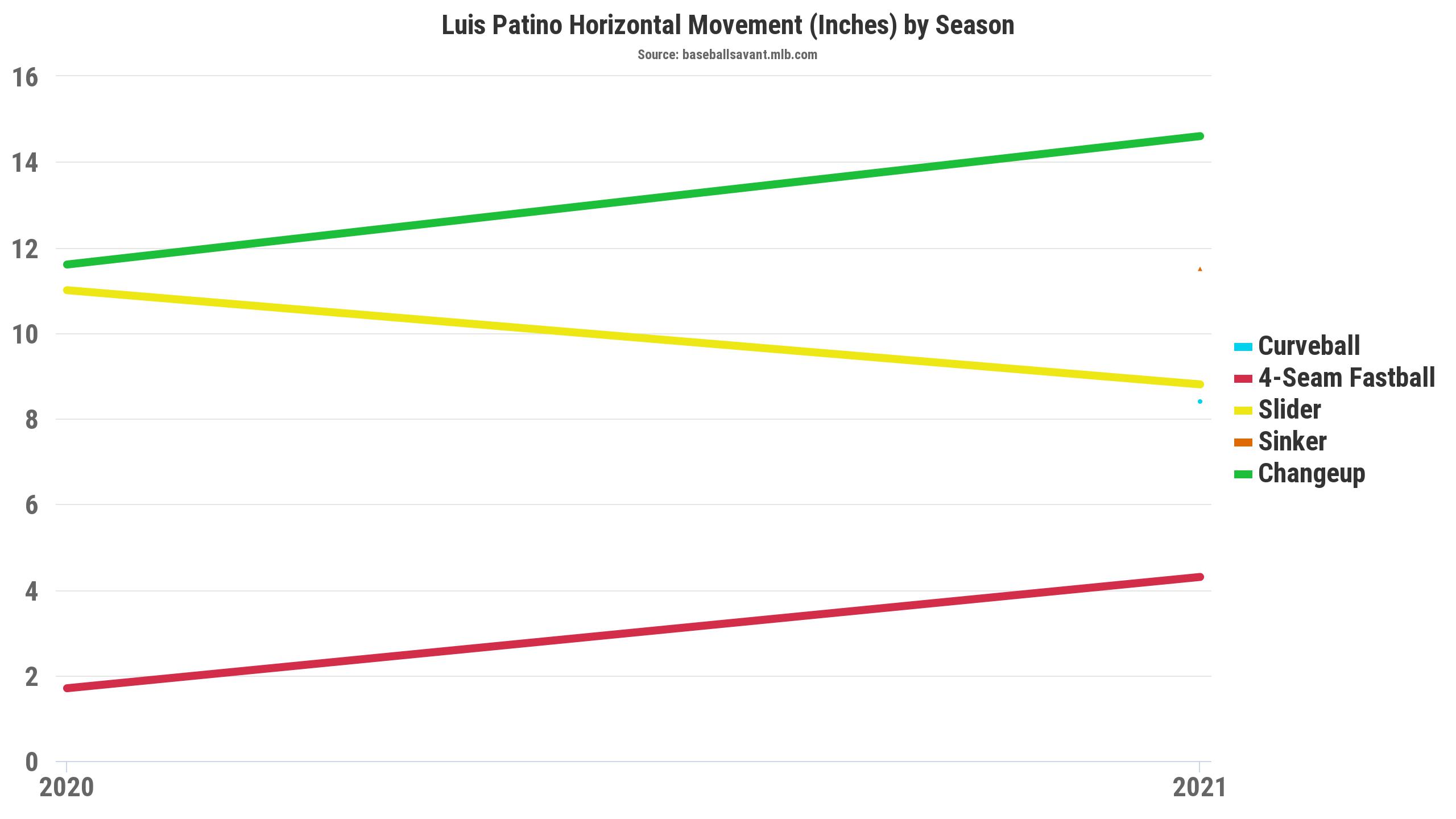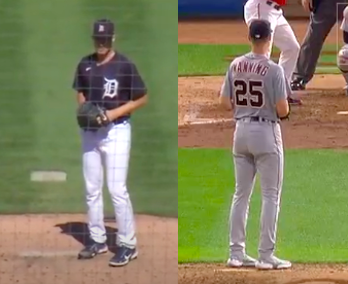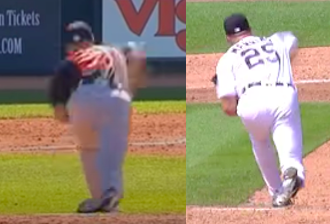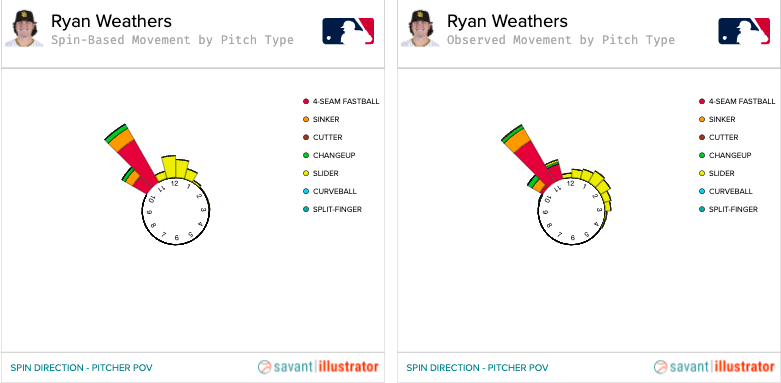When Luis Patiño was a dealt to the Rays as the headlining prospect in return for Blake Snell, baseball analysts – including myself – hypothesized ways that Tampa would turn him into their next developmental success story. The main reason for this was Patiño’s four-seam fastball, which he tended to cut even despite it’s above average rise. Naturally cutting fastballs are common amongst young pitchers (especially those with Patiño’s arm action), but can severely limit the pitch’s ability to get whiffs. There was a line of logic that the Rays would steer Patiño towards a more rising fastball, something they had done with other pitchers in the past, and the whiffs would follow suit.
After starting the season at Triple-A, Patiño returned to the majors and his pitches did look different. Like many hypothesized, his fastball had added rise – albeit minimally. Now, what about that horizontal movement?

Huh. There’s actually more of it. Patiño’s fastball went from moving one inch towards a right handed batter to over four inches.
There are a few small changes to note: First, Patiño is getting less extension across the board (down around two inches on all pitches). Minor mechanical tweaks have lowered his release point in 2021, importantly helping it become more consistent. With that, his fastball’s spin axis has slightly changed from 12:15 in 2020 to 12:30 in 2021. His active spin (the percent of spin that contributes to the ball’s movement) has increased as well, going from 83% in 2020 to 86% in 2021. Put together — slightly more efficient spin in a slightly more horizontal direction – and the resulting movement makes a whole lot of sense.
His slider has also shifted noticeably. Here it is from 2020:
https://gfycat.com/limpingslightamericanalligator
Now from 2021:
https://gfycat.com/energeticcircularhapuku
When he first signed with the Padres, Patiño’s best breaking pitch was a curve. He debuted in 2020 with a slider, though as you can see a very vertical slider could be easily mistaken for a firm curveball. Why shift to a more sweeping slider? It’s hard to argue with the results; a .239 xwOBA against and 36% whiff rate which made the slider Patiño’s most effective pitch in 2021. It might also be due to Patiño reintroducing the curveball to his arsenal. Though a he’s yet to use them extensively, and gotten lackluster results in a limited sample, Patiño has added a curve and sinker to his repertoire in 2021. Now not only is his new slider faring better, but it works better with his overall arsenal. With two distinct breaking balls, a developing changeup, and improving fastball characteristics, it’s obvious the Rays view Patiño as a starter long-term.
Arsenal development like this is key for young pitchers who look to start, so lets a look at three rookie starters and what they can do to help their chances.
Matt Manning entered the year as a consensus top-20 prospect, with the prototypical power pitcher’s profile and deep arsenal. He struggled mightily in his Triple-A debut after carving up Double-A in 2019, but got a major league call-up anyway. Those struggles carried over through his big league debut, seeing him post a 5.91 ERA, 4.96 FIP, and worryingly just 29 Ks in 53 innings.
Manning works with two fastball shapes, a four-seam and sinker. Both average just a tick above 93mph this season, which is mildly concerning for a power pitcher who regularly threw in the mid 90s or better. The idea behind these pitches is a rising 4-seamer to get whiffs and a sinker with drop to get grounders. Like Patiño though, Manning’s four-seam fastball gets around three inches of horizontal movement – which isn’t a ton – but combined with its extremely low spin rate (seventh percentile) and middling rise makes it a less -than-effective pitch. His sinker has similarly sub-par movement, and is actually quite similar to his four-seam. In current form, Manning has a four-seamer that doesn’t rise and a sinker that doesn’t drop. There’s no sugar coating it. That likely needs to change.
Manning needs further secondary development as well. Though his slider has a movement profile right around league average, among pitchers who’ve thrown at least 100 sliders in 2021 Manning’s xwoBA, whiff rate, and swinging strike rate all rank within the league’s bottom three.
The slider has been his go-to, and that is a questionable decision not just because of its ineffectiveness. As mentioned, Manning rose through the minors as a power pitcher. His 6’6” frame make him an imposing mound presence and his over-the-top arm slot should help maximize a vertically-oriented pitch mix. Perhaps the issue lies with Manning’s mechanics, which are noticeably stiff and lack fluidity.
In the minors, Manning started on the first base side of the rubber, with a long stride and cross-body delivery that allowed his fastball to play up. In the majors, Manning starts more to the third base side with a stride that looks shorter, stopping his momentum abruptly and making for an awkward follow-through.

2020 (Right) vs 2021 (Left)
Camera angles can make it hard to determine a pitcher’s stride length, but the position of their back foot coming off the rubber can be a subtle indication. As such, here is Manning’s with 2021 Spring Training on the left and his most recent start (8/19) on the right:

Once again camera angles make it tough to know for sure, but it looks to me like Manning’s stride is both shorter and more centered than before. The extension numbers seem to confirm as even though Manning is 6’6”, he averages just 6.9 feet of extension – the same as Luis Patiño, who is five inches shorter.
It’s right to assume the Tigers know what they are doing but I wonder if more extension could help Manning, with a more fluid follow-through helping both his fastball velocity and breaking ball shape. More focus more on curveball development would help as well, as it mirrors his four-seam and works better with the high arm slot. For better or worse the Tigers have let Manning develop at the Major League level this year, but the early returns suggest he still has quite a bit to work on.
Much of the same is true for Ryan Weathers, who was thrust into a postseason bullpen role in 2020 having not pitched above A-ball. He pitched well in that debut but has had mixed results since becoming a full time member of the Padres rotation in 2021. Health was a key factor in Weathers’ meteoric rise last season, having battled dead-arm in 2019 and struggling to regain his mid-90s velocity. Further questions were raised earlier in the 2021 season when he was pulled from a start against the Diamondbacks after sitting 86-88 in the first inning and subsequently being placed on the IL.
Arsenal development has always been paramount for Weathers, who possesses sterling slider command but has yet to form a compete repertoire around it. That doesn’t mean he isn’t trying though, and the four-pitch mix he’s worked with this year demonstrates a step in the right direction. The four-seam fastball and slider have remained go-to weapons for Weathers, but he’s added a sinker and changeup to the mix in 2021. The issue with is that all three of his non-slider offerings morph together. As shown below, Weather’s four-seamer, sinker, and changeup all have identical 10:15 spin direction, are separated by five inches of total movement, and only seven mph of velocity.

That is essentially three variations of the same pitch, none of which pair particularly well with Weather’s gyro-heavy slider.
With his four-seamer and sinker being especially similar, the changeup may offer the most promise for Weathers. It has nearly as much drop as his slider (though still well below average for its velocity), and can actually benefit from the fastball similarities. Though he only throws it to right-handed hitters, its .188 AVG, .250 SLG, and .276 xwOBA against are all best among Weathers’ offerings. He has the allure of a starter’s arsenal but is essentially still a two-pitch pitcher. As a result, whether he’s a starter or reliever remains to be seen.
Kyle Muller is another rookie pitcher who’s shown promise in 2021. His arsenal has consistently improved since he was a drafted in 2016. Back then, Muller’s fastball topped out around 93 mph with only a slow, looping curveball to go with it. In the years since, Muller added a gyro slider (shown below) and now possesses a fastball that’s gotten up to 98 (sitting 92-95 over longer outings).
https://gfycat.com/fastdetailedgopher
While he lacks the command that Weathers has, Muller’s gyro slider has become arguably his best pitch in less than a calendar year. It’s overtaken the slow curve as his go-to secondary and has the best combination of whiffs and contact suppression in his arsenal. He still utilizes the curve though, which has also benefited from the velocity boost (now comfortably 80-82), and mirrors his four-seamer well. With sharp break, it has the best bat-missing ability in his arsenal when located.
https://gfycat.com/ambitiousrigidgrackle
Those three pitches increase Muller’s ability to start long-term, as does the reworked changeup reportedly in development. Command will be the key for Muller, with his 12.9% walk rate at the major league level on par with his minor league career. Questions about his ability to start long-term still exist, but his arsenal improvements are promising and represent growing confidence in his long-term future in the rotation.
Photos from Icon Sportswire | Feature Image by Justin Redler (@reldernitsuj on Twitter)

